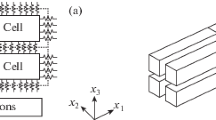Abstract
Much effort has been devoted to developing numerical techniques for solving the equations that describe cardiac electrophysiology, namely the monodomain equations and bidomain equations. Only a limited selection of publications, however, address the development of numerical techniques for mechanoelectric simulations where cardiac electrophysiology is coupled with deformation of cardiac tissue. One problem commonly encountered in mechanoelectric simulations is instability of the coupled numerical scheme. In this study, we develop a stable numerical scheme for mechanoelectric simulations. A number of convergence tests are carried out using this stable technique for simulations where deformations are of the magnitude typically observed in a beating heart. These convergence tests demonstrate that accurate computation of tissue deformation requires a nodal spacing of around 1 mm in the mesh used to calculate tissue deformation. This is a much finer computational grid than has previously been acknowledged, and has implications for the computational efficiency of the resulting numerical scheme.










Similar content being viewed by others
References
Costa, K. D., J. W. Holmes, and A. D. McCulloch. Modelling cardiac mechanical properties in three dimensions. Philos. Trans. R. Soc. Lond. A 359:1233-1250, 2001.
Guccione, J. M., K. D. Costa, and A. D. McCulloch. Finite element stress analysis of left ventricular mechanics in the beating dog heart. J. Biomech. 28:1167–1177, 1995.
Guccione, J. M., and A. D. McCulloch. Mechanics of active contraction in cardiac muscle: part I—constitutive relations for fibre stress that describe deactivation. Trans. ASME 115:72–81, 1993.
Gurev, V., M. M. Maleckar, and N. A. Trayanova. Cardiac defibrillation and the role of mechanoelectric feedback in postshock arrhythmogenesis. Ann. N. Y. Acad. Sci. 1080:320-333, 2006.
Hunter, P. J., A. D. McCulloch, and H. E. D. J. ter Keurs. Modelling the mechanical properties of cardiac muscle. Prog. Biophys. Mol. Biol. 69:289–331, 1998.
Hunter, P. J., M. P. Nash, and G. B. Sands. “Computational mechanics of the heart.” In: Computational Biology of the Heart, edited by A. V. Panfilov, and A. V. Holden, Wiley, West Sussex, UK, 1997, pp. 345–407.
Keener, J. P., and J. Sneyd. Mathematical Physiology. Springer-Verlag, New York, 1998.
Kerckhoffs, R. C. P., S. N. Healy, T. P. Usyk, and A. D. McCulloch. Computational methods for cardiac electromechanics. Proc. IEEE 94:769–783, 2006.
Luo, C. H., and Y. Rudy. A dynamic model of the cardiac ventricular action potential: I. Simulations of ionic currents and concentration changes. Circ. Res. 68: 1501–1526, 1991.
Nash, M. P., and P. J. Hunter. Computational mechanics of the heart. J. Elast. 61:113–141, 2000.
Nash, M. P., and A. V. Panfilov. Electromechanical model of excitable tissue to study reentrant cardiac arrhythmias. Prog. Biophys. Mol. Biol. 85:501–522, 2004.
Nickerson, D. P., M. P. Nash, P. F. Nielsen, N. P. Smith, and P. J. Hunter. Computational multiscale modeling in the IUPS Physiome Project: modeling cardiac electromechanics. IBM J. Res. Dev. 50:617–630, 2006.
Nickerson, D. P., N. P. Smith, and P. J. Hunter. New developments in a strongly coupled cardiac electromechanical model. Europace 7:S118–S127, 2005.
Niederer S. A., Hunter P. J., Smith N. P. (2006) A quantitative analysis of cardiac myocyte relaxation: a simulation study. Biophys. J. 90:1697–1722
Niederer, S. A., and N. P. Smith. An improved numerical method for strong coupling of excitation and contraction models in the heart. Prog. Biophys. Mol. Biol. 96:90–111, 2008.
Noble, D., A. Varghese, P. Kohl, and P. J. Noble. Improved guinea-pig ventricular cell model incorporating a diadic space, I Kr and I Ks , and length- and tension-dependent processes. Can. J. Cardiol. 14:123–134, 1998.
Peterson, J. N., W. C. Hunter, and M. R. Berman. Estimated time course of Ca2+ bound to troponin C during relaxation in isolated cardiac muscle. Am. J. Physiol. 260:H1013–H1024, 1991.
Remme, E. W., M. P. Nash, and P. J. Hunter. “Distributions of myocyte stretch, stress and work in models of normal and infarcted ventricles.” In: Cardiac Mechano-Electric Feedback and Arrhythmias: From Pipette to Patient, edited by P. Kohl, F. Sachs, and M. R. Franz, Saunders–Elsevier, UK, 2005, 381–391.
Schmid, H., M. P. Nash, A. A. Young, and P. J. Hunter. Myocardial material parameter estimation—a comparative study for simple shear. Trans. ASME 128:742–750, 2006.
Smith, N. P., D. P. Nickerson, E. J. Crampin, and P. J. Hunter. Multiscale computational modelling of the heart. Acta Numer. 13:371–431, 2004.
ten Tusscher, K. H. W. J. D, D. Noble, P. J. Noble and A. V. Panfilov. A model for human ventricular tissue. Am. J. Physiol. 286:H1573–H1589, 2004.
Usyk T. P., Mazhari R., McCulloch A. D. (2000) Effect of laminar orthotropic myofiber architecture on regional stress and strain in the canine left ventricle. J. Elast. 61:143–164
Whiteley, J. P. An efficient technique for the solution of the monodomain and bidomain equations. IEEE Trans. Biomed. Eng. 53:2139–2147, 2006.
Whiteley, J. P. Physiology driven adaptivity for the numerical solution of the bidomain equations. Ann. Biomed. Eng. 35:1510–1520, 2007.
Whiteley, J. P., M. J. Bishop, and D. J. Gavaghan. Soft tissue modelling of cardiac fibres for use in coupled mechano-electric simulations. Bull. Math. Biol. 69:2199–2225, 2007.
Whiteley, J. P., D. J. Gavaghan, S. J. Chapman and J. M. Brady. Non–linear modelling of breast tissue. Math. Med. Biol. 24:327–345, 2007.
Acknowledgments
PP is pleased to acknowledge the support of the EPSRC through grant EP/D048400/1, “New frontiers in the mathematics of solids,” and JPW is pleased to acknowledge the support of the EPSRC through grant EP/D503035/1.
Author information
Authors and Affiliations
Corresponding author
Rights and permissions
About this article
Cite this article
Pathmanathan, P., Whiteley, J.P. A Numerical Method for Cardiac Mechanoelectric Simulations. Ann Biomed Eng 37, 860–873 (2009). https://doi.org/10.1007/s10439-009-9663-8
Received:
Accepted:
Published:
Issue Date:
DOI: https://doi.org/10.1007/s10439-009-9663-8




